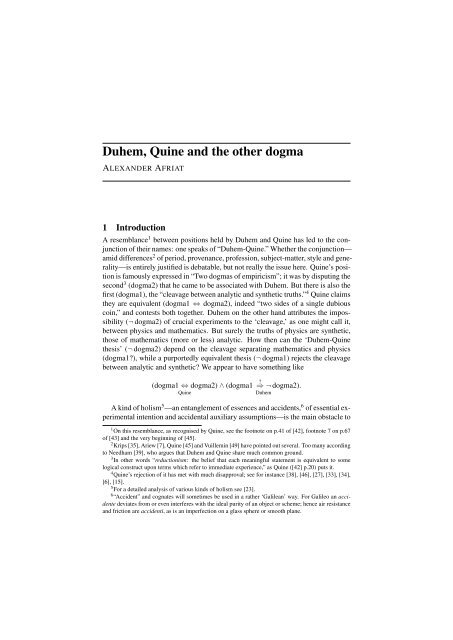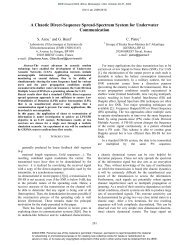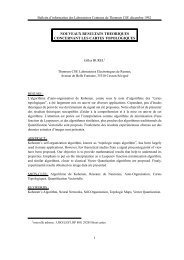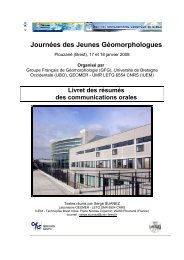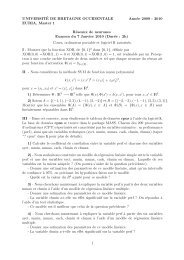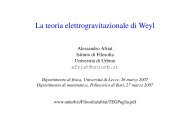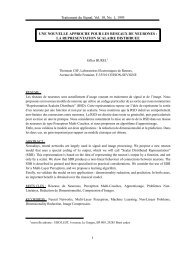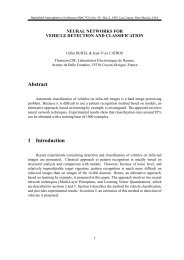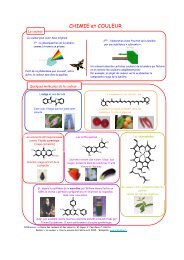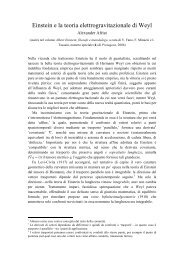Duhem, Quine and the other dogma
Duhem, Quine and the other dogma
Duhem, Quine and the other dogma
- No tags were found...
You also want an ePaper? Increase the reach of your titles
YUMPU automatically turns print PDFs into web optimized ePapers that Google loves.
<strong>Duhem</strong>, <strong>Quine</strong> <strong>and</strong> <strong>the</strong> o<strong>the</strong>r <strong>dogma</strong><br />
ALEXANDER AFRIAT<br />
1 Introduction<br />
A resemblance 1 between positions held by <strong>Duhem</strong> <strong>and</strong> <strong>Quine</strong> has led to <strong>the</strong> conjunction<br />
of <strong>the</strong>ir names: one speaks of “<strong>Duhem</strong>-<strong>Quine</strong>.” Whe<strong>the</strong>r <strong>the</strong> conjunction—<br />
amid differences 2 of period, provenance, profession, subject-matter, style <strong>and</strong> generality—is<br />
entirely justified is debatable, but not really <strong>the</strong> issue here. <strong>Quine</strong>’s position<br />
is famously expressed in “Two <strong>dogma</strong>s of empiricism”; it was by disputing <strong>the</strong><br />
second 3 (<strong>dogma</strong>2) that he came to be associated with <strong>Duhem</strong>. But <strong>the</strong>re is also <strong>the</strong><br />
first (<strong>dogma</strong>1), <strong>the</strong> “cleavage between analytic <strong>and</strong> syn<strong>the</strong>tic truths.” 4 <strong>Quine</strong> claims<br />
<strong>the</strong>y are equivalent (<strong>dogma</strong>1 ⇔ <strong>dogma</strong>2), indeed “two sides of a single dubious<br />
coin,” <strong>and</strong> contests both toge<strong>the</strong>r. <strong>Duhem</strong> on <strong>the</strong> o<strong>the</strong>r h<strong>and</strong> attributes <strong>the</strong> impossibility<br />
(¬ <strong>dogma</strong>2) of crucial experiments to <strong>the</strong> ‘cleavage,’ as one might call it,<br />
between physics <strong>and</strong> ma<strong>the</strong>matics. But surely <strong>the</strong> truths of physics are syn<strong>the</strong>tic,<br />
those of ma<strong>the</strong>matics (more or less) analytic. How <strong>the</strong>n can <strong>the</strong> ‘<strong>Duhem</strong>-<strong>Quine</strong><br />
<strong>the</strong>sis’ (¬ <strong>dogma</strong>2) depend on <strong>the</strong> cleavage separating ma<strong>the</strong>matics <strong>and</strong> physics<br />
(<strong>dogma</strong>1), while a purportedly equivalent <strong>the</strong>sis (¬ <strong>dogma</strong>1) rejects <strong>the</strong> cleavage<br />
between analytic <strong>and</strong> syn<strong>the</strong>tic We appear to have something like<br />
(<strong>dogma</strong>1 ⇔ <strong>dogma</strong>2) ∧ (<strong>dogma</strong>1<br />
<strong>Quine</strong><br />
⇒ ¬ <strong>dogma</strong>2).<br />
<strong>Duhem</strong><br />
A kind of holism 5 —an entanglement of essences <strong>and</strong> accidents, 6 of essential experimental<br />
intention <strong>and</strong> accidental auxiliary assumptions—is <strong>the</strong> main obstacle to<br />
1 On this resemblance, as recognised by <strong>Quine</strong>, see <strong>the</strong> footnote on p.41 of [42], footnote 7 on p.67<br />
of [43] <strong>and</strong> <strong>the</strong> very beginning of [45].<br />
2 Krips [35], Ariew [7], <strong>Quine</strong> [45] <strong>and</strong> Vuillemin [49] have pointed out several. Too many according<br />
to Needham [39], who argues that <strong>Duhem</strong> <strong>and</strong> <strong>Quine</strong> share much common ground.<br />
3 In o<strong>the</strong>r words “reductionism: <strong>the</strong> belief that each meaningful statement is equivalent to some<br />
logical construct upon terms which refer to immediate experience,” as <strong>Quine</strong> ([42] p.20) puts it.<br />
4 <strong>Quine</strong>’s rejection of it has met with much disapproval; see for instance [38], [46], [27], [33], [34],<br />
[6], [15].<br />
5 For a detailed analysis of various kinds of holism see [23].<br />
6 “Accident” <strong>and</strong> cognates will sometimes be used in a ra<strong>the</strong>r ‘Galilean’ way. For Galileo an accidente<br />
deviates from or even interferes with <strong>the</strong> ideal purity of an object or scheme; hence air resistance<br />
<strong>and</strong> friction are accidenti, as is an imperfection on a glass sphere or smooth plane.
2 Alex<strong>and</strong>er Afriat<br />
crucial experiments <strong>and</strong> (empirically grounded) meanings. Using notions hinted at<br />
by <strong>Duhem</strong> <strong>and</strong> <strong>Quine</strong>, formalised using <strong>the</strong> resources of set-<strong>the</strong>oretical axiomatisation,<br />
I argue that such holism <strong>and</strong> inextricability can be largely overcome. 7 Taking<br />
<strong>Quine</strong>’s association—however questionable—of essence, meaning, synonymy<br />
<strong>and</strong> analyticity for granted, I also argue that analyticity is rehabilitated to <strong>the</strong> extent<br />
that <strong>the</strong> aforementioned entanglement of essences <strong>and</strong> accidents is undermined. If<br />
this recovery of <strong>the</strong> analytic completely dissociates it from <strong>the</strong> syn<strong>the</strong>tic, giving<br />
it a distinct <strong>and</strong> separate identity, we arrive at <strong>the</strong> aforementioned paradox; for a<br />
rehabilitation of crucial experiments would appear to have <strong>the</strong> opposite effect on<br />
ma<strong>the</strong>matics <strong>and</strong> physics, by consolidating <strong>the</strong> cleavage between <strong>the</strong>m ra<strong>the</strong>r than<br />
undermining it. The matter is brought up, not for definite resolution, but to shed<br />
light on <strong>the</strong> web of issues involved, including relations between <strong>the</strong> arguments of<br />
<strong>Duhem</strong> <strong>and</strong> <strong>Quine</strong>.<br />
I begin (§2) with a scheme for overcoming holism by disentangling essences<br />
from accidents, which leads (§3) to a new characterisation of <strong>the</strong> meaning <strong>and</strong><br />
reference of sentences, involving ‘abstract tests.’ After noting (§4) that <strong>Duhem</strong><br />
<strong>and</strong> <strong>Quine</strong> <strong>the</strong>mselves already adumbrated such tests I show how <strong>the</strong>y can be formalised<br />
in <strong>the</strong> language of model <strong>the</strong>ory, in fact of set-<strong>the</strong>oretical axiomatisation.<br />
A quantum-mechanical example is looked at in §5. In §6 I consider how <strong>Quine</strong><br />
relates meaning, essence <strong>and</strong> analyticity, in §7 how <strong>Duhem</strong> relates <strong>the</strong> cleavage<br />
between physics <strong>and</strong> ma<strong>the</strong>matics to <strong>the</strong> impossibility of crucial experiments, <strong>and</strong><br />
whe<strong>the</strong>r holism really does have conflicting implications for <strong>Duhem</strong> <strong>and</strong> for <strong>Quine</strong>.<br />
2 Essences, accidents <strong>and</strong> holism<br />
“The Aristotelian notion of essence,” writes <strong>Quine</strong> ([42] p.22), “was <strong>the</strong> forerunner,<br />
no doubt, of <strong>the</strong> modern notion of [. . . ] meaning. [. . . ] Things had essences,<br />
for Aristotle, but only linguistic forms have meanings. Meaning is what essence<br />
becomes when it is divorced from <strong>the</strong> object of reference <strong>and</strong> wedded to <strong>the</strong> word.”<br />
Much here 8 turns on <strong>the</strong> fact that <strong>the</strong>re is more to <strong>the</strong> object 9 of reference than just<br />
<strong>the</strong> essence intended—for if <strong>the</strong> essence exhausted <strong>the</strong> object why speak of an<br />
essence at all. Since <strong>the</strong>re is more to it, we can distinguish between <strong>the</strong> essence<br />
<strong>and</strong> <strong>the</strong> rest or accident. Perhaps an essence is best viewed as being ‘embodied’ in<br />
an object, which bears <strong>the</strong> essence along with unintended accidental features.<br />
7 Similar claims abound in <strong>the</strong> literature, e.g. “A naive holism that supposes <strong>the</strong>ory to confront<br />
experience as an unstructured, blockish whole will inevitably be perplexed by <strong>the</strong> power of scientific<br />
argument to distribute praise <strong>and</strong> to distribute blame among our beliefs” [25]. See also [28], [29]—<br />
<strong>Quine</strong> replies in [44], Laudan defends <strong>Duhem</strong> in [36], claiming that Grünbaum has attacked too strong<br />
a version of “<strong>the</strong> <strong>Duhem</strong>ian argument”—[26] <strong>and</strong> [6].<br />
8 This section serves only to introduce <strong>the</strong> next, <strong>and</strong> a notation, without any pretence of contributing<br />
to <strong>the</strong> abundant literature on <strong>the</strong> subject.<br />
9 Here an ‘object’ will be a physical object—even if ma<strong>the</strong>matical objects have been considered ever<br />
since <strong>the</strong> early days of <strong>the</strong> meaning-reference distinction; see [24] p.26 for instance.
<strong>Duhem</strong>, <strong>Quine</strong> <strong>and</strong> <strong>the</strong> o<strong>the</strong>r <strong>dogma</strong> 3<br />
A given meaning, <strong>the</strong>n, breaks an object up into essential <strong>and</strong> accidental features,<br />
<strong>the</strong> latter being unintended <strong>and</strong> dispensable, in <strong>the</strong> sense that without <strong>the</strong>m<br />
<strong>the</strong> object would remain ‘what it is’ <strong>and</strong> not be ontologically compromised. The<br />
idea is that since a man after a haircut undoubtedly remains a man, what’s left on<br />
<strong>the</strong> barber’s floor was accidental.<br />
Suppose a word W refers to an object O characterised by certain features F =<br />
{F 1 , F 2 , . . .}. Whereas reference catches all <strong>the</strong> features, essential <strong>and</strong> accidental,<br />
only <strong>the</strong> essential ones ¯F are meant by W . Even if we know that ¯F is a proper<br />
subset of F , it may be less clear exactly which elements make it up. Hence <strong>the</strong><br />
following test: remove <strong>the</strong> features one by one, <strong>and</strong> see what happens; if F 1 is<br />
removed <strong>and</strong> <strong>the</strong> object with features {F 2 , F 3 , . . .} is still intended, F 1 was not<br />
essential, <strong>and</strong> so on. Of course <strong>the</strong> test cannot be conclusive since <strong>the</strong> essences ¯F<br />
are never found on <strong>the</strong>ir own, without accidents, some of which will necessarily<br />
be tangled up with essences (which could o<strong>the</strong>rwise exhaust <strong>the</strong> object). Suppose<br />
a physical constraint prevents F m from being separated from F n . We notice that<br />
W still applies when both are present, <strong>and</strong> that it no longer does once <strong>the</strong>y have<br />
been removed. What <strong>the</strong>n We cannot tell <strong>the</strong> three cases (1. F m ∈ ¯F , F n /∈ ¯F ;<br />
2. F m /∈ ¯F , F n ∈ ¯F ; 3. F m ∈ ¯F , F n ∈ ¯F ) apart <strong>and</strong> must <strong>the</strong>refore wonder about<br />
dispensability; for if a feature F m cannot be removed without taking something<br />
essential with it, in what sense was that feature dispensable <strong>and</strong> hence accidental<br />
F m <strong>and</strong> F n may be conceptually separable, just by thought, but physical separation<br />
can be considered more trustworthy <strong>and</strong> ‘empirical.’ This entanglement of essence<br />
<strong>and</strong> accident already adumbrates <strong>the</strong> holisms of <strong>Duhem</strong> <strong>and</strong> <strong>Quine</strong>.<br />
For proper names <strong>and</strong> single objects <strong>the</strong> problem is insurmountable. But even if<br />
<strong>the</strong> essential features ¯F cannot exist on <strong>the</strong>ir own, without accidental ones of some<br />
kind or o<strong>the</strong>r, <strong>the</strong>y may be found with different sets of accidental features: W<br />
could refer to various objects (which perhaps constitute a ‘natural kind’). In o<strong>the</strong>r<br />
words ¯F may be accompanied by <strong>the</strong> accidents {F 1 1 , F 1 2 , . . .} or by {F 2 1 , F 2 2 , . . .}<br />
or {F 3 1 , F 3 2 , . . .} etc., in which case W , while meaning ¯F , would refer to object<br />
O 1 with features F 1 = { ¯F , F 1 1 , F 1 2 , . . .} or to object O 2 with features F 1 =<br />
{ ¯F , F 2 1 , F 2 2 , . . .} <strong>and</strong> so on. Even without knowing <strong>the</strong> exact makeup of ¯F beforeh<strong>and</strong>,<br />
it is clearly a subset of ˆF = ⋂ F i ; <strong>and</strong> if <strong>the</strong> family of objects O 1 , O 2 , . . .<br />
is sufficiently large <strong>and</strong> <strong>the</strong> accidental features sufficiently varied, one can reasonably<br />
identify ¯F with ˆF . The extension of W , if large <strong>and</strong> varied enough, <strong>the</strong>refore<br />
allows us to determine <strong>the</strong> intended essence. The idea being that even if that<br />
essence cannot be physically abstracted from <strong>the</strong> bearing object, with all its accidents,<br />
it can be abstracted from particular accidents (ra<strong>the</strong>r than o<strong>the</strong>rs); for <strong>the</strong><br />
distinguished features ¯F emerge as <strong>the</strong> ones belonging to all <strong>the</strong> objects.<br />
But of course not all linguistic forms are words. <strong>Quine</strong> seems to have been<br />
chiefly concerned with sentences, to whose meaning <strong>and</strong> reference we now turn.
4 Alex<strong>and</strong>er Afriat<br />
3 The meaning <strong>and</strong> reference of sentences<br />
For <strong>the</strong> empiricists an empirical procedure O was needed to give meaning to an<br />
(observation) 10 sentence W . But <strong>Quine</strong> wonders whe<strong>the</strong>r even that will work; for<br />
such an O cannot help entangling W with <strong>the</strong> world in a messy, complicated way,<br />
involving all sorts of unintended sentences, or ra<strong>the</strong>r ‘collateral’ 11 experimental<br />
features corresponding to assumptions one might even call ‘accidental.’ So we<br />
again have a holistic problem of entanglement: an inextricability of ideal experimental<br />
essence or intention <strong>and</strong> unavoidable experimental accidents needed to<br />
implement that intention in <strong>the</strong> world. This is already reminiscent of <strong>the</strong> meaning<br />
<strong>and</strong> reference of words, <strong>and</strong> indeed I will propose a parallel characterisation<br />
for sentences, emphasised by a similar notation. Whereas sets <strong>and</strong> <strong>the</strong>ir intersections<br />
were enough to separate essences from accidents in my treatment of words,<br />
resources from elementary model <strong>the</strong>ory will be used to effect <strong>the</strong> separation for<br />
sentences <strong>and</strong> <strong>the</strong> experiments used to test <strong>the</strong>m.<br />
Frege extended his Sinn-Bedeutung distinction from words to statements:<br />
Wir fragen nun nach Sinn und Bedeutung eines ganzen Behauptungssatzes.<br />
Ein solcher Satz enthält einen Gedanken. Ist dieser Gedanke<br />
nun als dessen Sinn oder als dessen Bedeutung anzusehen 12<br />
A few lines on:<br />
Der Gedanke kann also nicht die Bedeutung des Satzes sein, vielmehr<br />
werden wir ihn als den Sinn aufzufassen haben. Wie ist es nun aber mit<br />
der Bedeutung Dürfen wir überhaupt danach fragen Hat vielleicht<br />
ein Satz als Ganzes nur einen Sinn, aber keine Bedeutung 13<br />
In due course he answers:<br />
So werden wir dahin gedrängt, den Wahrheitswert eines Satzes als<br />
seine Bedeutung anzuerkennen. Ich verstehe unter dem Wahrheitswerte<br />
eines Satzes den Umst<strong>and</strong>, daß es wahr oder daß er falsch ist. 14<br />
10 Classification of sentences is not <strong>the</strong> issue here. Or ra<strong>the</strong>r it presupposes distinctions (analytic/syn<strong>the</strong>tic<br />
etc.) that are <strong>the</strong> issue, <strong>and</strong> are best approached directly as such, ra<strong>the</strong>r than indirectly<br />
in a derivative attempt at classifying sentences.<br />
11 Indeed one is reminded of <strong>the</strong> “collateral information” of [43], esp. §§9,10.<br />
12 [24] p.32. <strong>Quine</strong> may be in question, but not <strong>the</strong> indeterminacy of translation ([43], esp. §§12-16),<br />
in acceptance of which quotations have been left in <strong>the</strong> original. Translation: “We now wonder about<br />
<strong>the</strong> meaning <strong>and</strong> reference of a whole affirmative sentence. Such a sentence contains a thought. Is this<br />
thought to be viewed as its meaning or as its reference” (The translations are mine.)<br />
13 Translation: “So <strong>the</strong> thought cannot be <strong>the</strong> reference of <strong>the</strong> sentence, ra<strong>the</strong>r we will have to take it<br />
as <strong>the</strong> meaning. What about <strong>the</strong> reference Should we wonder about it at all Does an entire sentence<br />
only have a meaning, but no reference”<br />
14 P.34. Translation: “We will thus be obliged to recognise <strong>the</strong> truth-value of a sentence as its reference.<br />
By <strong>the</strong> truth-value of a sentence I mean <strong>the</strong> circumstance, that it is true or that it is false.”
<strong>Duhem</strong>, <strong>Quine</strong> <strong>and</strong> <strong>the</strong> o<strong>the</strong>r <strong>dogma</strong> 5<br />
But since <strong>the</strong> leap from an object to a truth-value 15 is considerable, this seems an<br />
unnatural extension—however justified within his scheme—of <strong>the</strong> nomenclature<br />
first adopted for words.<br />
Attempting, <strong>the</strong>n, a natural extension of <strong>the</strong> meaning-reference distinction from<br />
words to sentences, I suggest that a single experiment O provides not <strong>the</strong> meaning<br />
of a sentence—for <strong>the</strong> reasons urged by <strong>Quine</strong>—but something more like<br />
its ‘reference.’ With <strong>the</strong> analogy between experiments <strong>and</strong> physical objects in<br />
mind I propose, <strong>the</strong>n, to say that a sentence W refers to a specific experiment—<br />
to experiment O 1 with features F 1 = { ¯F , F1 1 , F2 1 , . . .} or to O 2 with features<br />
F 2 = { ¯F , F1 2 , F2 2 , . . .} or to O 3 etc.—<strong>and</strong> that its meaning is given by <strong>the</strong> subset<br />
¯F of ˆF = ⋂ F i that corresponds to W by expressing an ideal experimental intention,<br />
an abstract logical core. It is up to <strong>the</strong> ingenuity of <strong>the</strong> experimenters to<br />
reduce ˆF to ¯F by producing enough experiments, with sufficiently varied auxiliary<br />
assumptions. Or ra<strong>the</strong>r <strong>the</strong> experimenters begin with <strong>the</strong> experimental intention ¯F<br />
expressing W , <strong>and</strong> <strong>the</strong>n go about finding many different ways to implement it<br />
physically. The trouble is that ¯F is a tenuous, ideal object, which cannot be performed<br />
on its own; auxiliary features 16 of some kind or o<strong>the</strong>r are needed to realise<br />
it, to bring it about. <strong>Quine</strong>’s point is roughly that W cannot be determined empirically<br />
because its counterpart ¯F cannot be carried out alone, without accidental<br />
auxiliary features, which <strong>the</strong>n confuse <strong>the</strong> logic of <strong>the</strong> experiment by unavoidable<br />
entanglement with ¯F .<br />
The various experiments could agree or disagree. Disagreement complicates<br />
matters; for <strong>the</strong>n which are to be trusted Would <strong>the</strong> majority, or perhaps some<br />
privileged experiment or subclass of <strong>the</strong>m, necessarily be right To avoid such<br />
complications unanimity will be required: <strong>the</strong> experiments must all yield <strong>the</strong> same<br />
verdict. 17 It will <strong>the</strong>n be claimed that, taken toge<strong>the</strong>r, <strong>the</strong>y are crucial. Such ‘cruciality’<br />
rests on <strong>the</strong> variety <strong>and</strong> prior plausibility of <strong>the</strong> auxiliary assumptions.<br />
Variety guarantees independence—for if <strong>the</strong> assumptions resemble each o<strong>the</strong>r too<br />
much, agreement will be no surprise 18 —<strong>and</strong> prior plausibility is inherited from<br />
o<strong>the</strong>r contexts. So I will assume that <strong>the</strong> validity of every auxiliary assumption Fb<br />
a<br />
made in each experiment O a was established in several o<strong>the</strong>r experimental contexts<br />
{O b1 , O b2 , . . .}; <strong>and</strong> fur<strong>the</strong>rmore that validity so established is maintained<br />
in <strong>the</strong> particular experiment O a ; a, b = 1, 2, . . . . The unanimity of <strong>the</strong> verdict<br />
cannot <strong>the</strong>n be reasonably attributed to a conspiracy of <strong>the</strong> auxiliary assumptions<br />
{F1 1 , F2 1 , . . .}, {F1 2 , F2 2 , . . .}, . . . ; it must be due to <strong>the</strong> experimental intention ¯F .<br />
Ano<strong>the</strong>r approach, adopted by Grice <strong>and</strong> Strawson ([27] p.156) in response to<br />
15 Admittedly an object of sorts too, but a very particular one.<br />
16 Auxiliary features <strong>and</strong> assumptions seem closely related enough to justify conflation.<br />
17 Perhaps disagreement is more common or likely than agreement; but unanimous agreement remains<br />
possible none<strong>the</strong>less.<br />
18 As has been pointed out to me by John Earman <strong>and</strong> John Norton. The st<strong>and</strong>ard resources of<br />
confirmation <strong>the</strong>ory, such as probabilities, have been deliberately avoided here.
6 Alex<strong>and</strong>er Afriat<br />
<strong>Quine</strong>, is to deal with <strong>the</strong> troublesome auxiliary statements Fb a<br />
assumptions about <strong>the</strong>[ir] truth-values”:<br />
by making “certain<br />
[. . . ] two statements are synonymous if <strong>and</strong> only if any experiences<br />
which, on certain assumptions about <strong>the</strong> truth-values of o<strong>the</strong>r statements,<br />
confirm or disconfirm one of <strong>the</strong> pair, also, on <strong>the</strong> same assumptions,<br />
confirm or disconfirm <strong>the</strong> o<strong>the</strong>r to <strong>the</strong> same degree.<br />
But surely <strong>the</strong> truth-values of statements are subject to <strong>the</strong> same holistic entanglement<br />
as <strong>the</strong>ir meanings. Why should truth-values be less empirical, less susceptible<br />
to <strong>the</strong> intricacies of empirical determination, than meanings Of course<br />
one could, while obliging meanings to maintain <strong>the</strong> empirical grounding that’s<br />
causing all <strong>the</strong> trouble, arbitrarily adopt an ‘ontological’ notion of truth <strong>and</strong> truthvalues,<br />
admitting <strong>the</strong> very kind of purely conceptual disentanglement that holism<br />
precludes for empirical meanings—but surely <strong>the</strong> problems at issue here would<br />
<strong>the</strong>reby be left untouched. So one can wonder about <strong>the</strong> legitimacy of a finegrained,<br />
detailed (ontological) assignment of individual truth-values, within <strong>and</strong><br />
alongside <strong>the</strong> messy tangle of (empirical) meanings, when <strong>the</strong> ‘atoms’ of meaning<br />
are so much larger than <strong>the</strong> ‘atoms’ of truth.<br />
In <strong>the</strong> approach I propose, <strong>the</strong> unanimity of <strong>the</strong> verdict provides a posteriori<br />
support for <strong>the</strong> prior plausibility of <strong>the</strong> auxiliary assumptions.<br />
4 Abstract tests<br />
Before attempting a characterisation of abstract tests we note that a similar idea<br />
can already be found in La théorie physique:<br />
Pour apprécier la variation de la force électromotrice, il pourra employer<br />
successivement tous les types connus d’électromètres, de galvanomètres,<br />
d’électrodynamomètres, de voltmètres [. . .]. Cependant,<br />
toutes ces manipulations, si diverses qu’un profane n’apercevrait entre<br />
elles aucune analogie, ne sont pas vraiment des expériences différentes ;<br />
ce sont seulement des formes différentes d’une même expérience ; les<br />
faits qui se sont réellement produits ont été aussi dissemblables que<br />
possible ; cependant la constatation de ces faits s’exprime par cet unique<br />
énoncé : La force électromotrice de telle pile augmente de tant de volts<br />
lorsque la pression augmente de tant d’atmosphères. 19<br />
19 P.224; emphasis mine. Translation: “To appreciate <strong>the</strong> variation of electromotive force, he can employ<br />
in succession all <strong>the</strong> known kinds of eletrometers, galvanometers, eletrodynamometers, voltmeters<br />
[. . . ]. However, all <strong>the</strong>se manipulations, so different that a layman would see no analogy among <strong>the</strong>m,<br />
are not really different experiments; <strong>the</strong>y are only different forms of a single experiment; <strong>the</strong> facts that<br />
really occurred were as different as possible, but can none<strong>the</strong>less be expressed in <strong>the</strong> same way: The<br />
electromotive force of such <strong>and</strong> such a battery increases by so many volts when <strong>the</strong> pressure increases<br />
by so many atmospheres.”
<strong>Duhem</strong>, <strong>Quine</strong> <strong>and</strong> <strong>the</strong> o<strong>the</strong>r <strong>dogma</strong> 7<br />
An expérience here is not a particular real experiment, subject to <strong>the</strong> difficulties<br />
<strong>Duhem</strong> will raise later, in Ch.VI §§II,III, but a class of equivalent experiments that<br />
all test or measure <strong>the</strong> same thing. Such an abstract experiment can be associated<br />
with <strong>the</strong> class of its formes différentes in <strong>the</strong> same way a <strong>the</strong>ory (in <strong>the</strong> logical,<br />
Tarskian sense) can be identified with all its models. The accidental <strong>and</strong> logically<br />
confusing peculiarities of particular implementation are thus transcended.<br />
There is something similar in Word <strong>and</strong> object (p.32) too: “We may begin by<br />
defining <strong>the</strong> affirmative stimulus meaning of a sentence [. . . ] as <strong>the</strong> class of all <strong>the</strong><br />
stimulations [. . . ] that would prompt [. . . ] assent.” A couple of pages on:<br />
[. . . ] a stimulation must be conceived for <strong>the</strong>se purposes not as a dated<br />
particular event but as a universal, a repeatable event form. We are to<br />
say not that two like stimulations have occurred, but that <strong>the</strong> same<br />
stimulation has recurred. Such an attitude is implied <strong>the</strong> moment we<br />
speak of sameness of stimulus meaning for two speakers. 20<br />
Here <strong>the</strong> models are <strong>the</strong> ‘repetitions’ of <strong>the</strong> “repeatable event form.”<br />
So both <strong>Duhem</strong> <strong>and</strong> <strong>Quine</strong> have in mind an abstract test—an abstract expérience,<br />
a universal, a repeatable form—with many particular realisations. It is in such tests<br />
that <strong>the</strong> desired cruciality will be sought.<br />
One can wonder about appropriate formalisation, for <strong>the</strong> notion is nebulous <strong>and</strong><br />
of little use as it st<strong>and</strong>s. What <strong>the</strong> various realisations of an abstract test have in<br />
common is structure 21 of some sort; it is in that sense that <strong>the</strong>y all test <strong>the</strong> same<br />
thing. But <strong>the</strong>re remains <strong>the</strong> matter of what exactly “structure” is. The ordinary<br />
connotations of <strong>the</strong> word will hardly do; <strong>Duhem</strong> <strong>and</strong> <strong>Quine</strong>, who speak of form,<br />
provide little help. Specification of a means of description can clarify: of <strong>the</strong><br />
many available ways of characterizing structure, <strong>the</strong> resources of set-<strong>the</strong>oretical<br />
axiomatisation, associated chiefly with Patrick Suppes (e.g. [48]) seem appropriate<br />
<strong>and</strong> will be used. In his language a set-<strong>the</strong>oretical predicate defines a <strong>the</strong>ory,<br />
satisfied by models, whereas here <strong>the</strong> predicate will characterise an abstract test,<br />
again satisfied by models. It is <strong>the</strong> abstract test, ra<strong>the</strong>r than any particular model,<br />
that represents a crucial experiment. Auxiliary assumptions have admittedly to be<br />
made in each individual implementation, but again, <strong>the</strong>y can be required to vary<br />
widely over <strong>the</strong> class, <strong>and</strong> to have a plausibility derived from o<strong>the</strong>r contexts.<br />
The idea can be formalised by spelling out a set-<strong>the</strong>oretical predicate, after <strong>the</strong><br />
manner of Suppes: a string (A, B, . . . ) of primitive notions ‘is an X,’ for instance,<br />
if certain axioms, say<br />
20 P.34. <strong>Quine</strong> argues, especially in [43] §§11,12, that stimulus meaning does not fix meaning well<br />
enough for all purposes <strong>and</strong> criteria. But his reservations, which regard behavioural linguistics, need<br />
not concern us here, especially as his characterisation of stimulus meaning is being taken only as a hint<br />
or rough ancestor.<br />
21 In <strong>the</strong> logical literature “structure” is often a synonym of “model,” whereas here its meaning is<br />
closer to that of “<strong>the</strong>ory.”
8 Alex<strong>and</strong>er Afriat<br />
1. A is a nonempty finite set.<br />
2. The function B : A → R + is differentiable <strong>and</strong> . . .<br />
3. . . .<br />
.<br />
are satisfied. Any such particular O a = (A a , B a , . . . ) satisfying <strong>the</strong> axioms is a<br />
model. The extension of <strong>the</strong> predicate ‘is an X’ is <strong>the</strong> set {O 1 , O 2 , . . .} of models.<br />
We are again dealing with essences <strong>and</strong> accidents, in <strong>the</strong> sense that a set<strong>the</strong>oretical<br />
predicate defines <strong>the</strong> ‘essence’ ¯F common to all <strong>the</strong> models. Essential<br />
<strong>and</strong> accidental features are entangled, <strong>and</strong> indeed can be hard to tell apart, in any<br />
particular model O a , which has its own contingent peculiarities {F a 1 , F a 2 , . . .} in<br />
addition to <strong>the</strong> common, essential core ¯F determined by <strong>the</strong> axioms. But once that<br />
model is considered alongside o<strong>the</strong>rs, essences can be made out as what is common<br />
to all of <strong>the</strong>m. The abstract test ¯F , in o<strong>the</strong>r words <strong>the</strong> set-<strong>the</strong>oretical predicate<br />
‘is an ¯F -test,’ <strong>the</strong>refore gives <strong>the</strong> meaning of <strong>the</strong> sentence W , which refers to any<br />
model O a of <strong>the</strong> test.<br />
The cleavage between ma<strong>the</strong>matics <strong>and</strong> physics is largely overcome by such<br />
abstract tests, which, being ma<strong>the</strong>matical objects in <strong>the</strong>mselves (despite having<br />
physical models), give physics much of <strong>the</strong> rigid necessity of ma<strong>the</strong>matics. In<br />
§7 I consider <strong>the</strong> differences <strong>Duhem</strong> attributes to ma<strong>the</strong>matics <strong>and</strong> physics, in §6<br />
<strong>the</strong> way <strong>Quine</strong> links analyticity <strong>and</strong> ‘reductionist’ meanings, after a much-needed<br />
example.<br />
5 Example: Bell’s inequality<br />
If ever a scientific controversy stood sorely in need of experimental arbitration,<br />
<strong>the</strong> dispute over <strong>the</strong> foundations of quantum mechanics that developed around <strong>the</strong><br />
positions of Einstein (e.g. [22]) <strong>and</strong> Bohr (e.g. [16] or [17]) certainly did (<strong>and</strong><br />
still does). There have been celebrated efforts to satisfy <strong>the</strong> need; experiments to<br />
test Bell’s inequality ([12], [14], <strong>and</strong> also [5]) by Alain Aspect <strong>and</strong> o<strong>the</strong>rs (e.g.<br />
[8], [9], [10], [11], [18], [40], [50]) have been among <strong>the</strong> most spectacular <strong>and</strong><br />
controversial attempts at empirical discrimination. But far from settling <strong>the</strong> debate<br />
<strong>the</strong>y have given it new life <strong>and</strong> vigour . . .<br />
The hope at any rate was this: Supposez (to follow <strong>Duhem</strong>) que deux hypothèses<br />
seulement soient en présence ;—local realism is ei<strong>the</strong>r valid or not—cherchez des<br />
conditions expérimentales telles que l’une des hypothèses annonce la production<br />
d’un phénomène et l’autre la production d’un phénomène tout différent ;—Bell’s<br />
inequality is ei<strong>the</strong>r satisfied or violated—réalisez ces conditions et observez ce qui<br />
se passe ; selon que vous observerez le premier des phénomènes prévu ou le second,<br />
vous condamnerez la seconde hypothèse ou la première ; celle qui ne sera
<strong>Duhem</strong>, <strong>Quine</strong> <strong>and</strong> <strong>the</strong> o<strong>the</strong>r <strong>dogma</strong> 9<br />
pas condamnée sera désormais incontestable ; le débat sera tranché, une vérité<br />
nouvelle sera acquise à la Science. 22 Of course such conclusions are unwarranted,<br />
resting on assumptions that may be no less questionable than <strong>the</strong> principles supposedly<br />
refuted. Bell (1986) for instance “always emphasize[d] that <strong>the</strong> Aspect<br />
experiment is too far from <strong>the</strong> ideal in many ways—counter efficiency is only one<br />
of <strong>the</strong>m,” <strong>and</strong> “that <strong>the</strong>re is <strong>the</strong>refore a big extrapolation from practical present-day<br />
experiments to <strong>the</strong> conclusion that nonlocality holds.”<br />
Most attempts to test Bell’s inequality, such as those of Aspect et al., have<br />
involved photons, but <strong>the</strong>se are seldom detected; this is <strong>the</strong> issue of “counter efficiency”<br />
referred to by Bell. To violate a Bell inequality with photons, assumptions<br />
(i.e. accidental features F a b ) like<br />
or<br />
Given a pair of photons emerging from two regions of space where<br />
two polarizers can be located, <strong>the</strong> probability of <strong>the</strong>ir joint detection<br />
from two photomultipliers [. . . ] does not depend on <strong>the</strong> presence <strong>and</strong><br />
<strong>the</strong> orientation of <strong>the</strong> polarizers. [19]<br />
The set of detected pairs with a given orientation of <strong>the</strong> polarizers is<br />
an undistorted representative sample of <strong>the</strong> set of pairs emitted by <strong>the</strong><br />
source. [8]<br />
have to be made. For our purposes <strong>the</strong>y are equivalent, <strong>and</strong> give rise to <strong>the</strong> same<br />
consequences: <strong>the</strong>y multiply <strong>the</strong> interval figuring in <strong>the</strong> inequality by <strong>the</strong> product<br />
of <strong>the</strong> efficiencies of <strong>the</strong> counters. The assumptions turn an interval running from<br />
−1 to 1, for instance, into one running from −η 1 η 2 to η 1 η 2 where η 1 <strong>and</strong> η 2 are <strong>the</strong><br />
efficiencies. If <strong>the</strong> counters are relatively efficient, <strong>and</strong> each detect, say, a photon in<br />
four, <strong>the</strong> assumptions make <strong>the</strong> inequality sixteen times easier to violate. 23 This is<br />
<strong>the</strong> idea: Averaging involves adding up N terms, <strong>the</strong>n dividing by N. But what if<br />
most of <strong>the</strong> terms are ‘duds,’ <strong>and</strong> do not contribute to <strong>the</strong> sum Surely dividing by<br />
N is excessive; does it not make more sense to divide by <strong>the</strong> number of valid terms<br />
instead In o<strong>the</strong>r words only a small fraction of <strong>the</strong> pairs get detected, so why not<br />
take that same fraction of <strong>the</strong> interval After all, why should <strong>the</strong> sample not be<br />
representative of <strong>the</strong> whole population Surely <strong>the</strong> photomultipliers act r<strong>and</strong>omly<br />
<strong>and</strong> indiscriminately . . .<br />
22 [21] p.286. Translation: “Suppose only two hypo<strong>the</strong>ses are at issue; seek experimental conditions<br />
such that one of <strong>the</strong> hypo<strong>the</strong>ses leads to <strong>the</strong> production of one phenomenon <strong>and</strong> <strong>the</strong> o<strong>the</strong>r to <strong>the</strong><br />
production of a completely different phenomenon; realise <strong>the</strong>se conditions <strong>and</strong> observe what happens;<br />
according to whe<strong>the</strong>r you observe <strong>the</strong> first of <strong>the</strong> predicted phenomena or <strong>the</strong> second, you will condemn<br />
<strong>the</strong> second hypo<strong>the</strong>sis or <strong>the</strong> first; <strong>the</strong> one that will not be condemned will be incontestable; <strong>the</strong> issue<br />
will be settled, <strong>and</strong> Science will have a new truth.”<br />
23 Franco Selleri expresses this by distinguishing between strong <strong>and</strong> weak inequalities, described in<br />
[37], [5] <strong>and</strong> [2].
10 Alex<strong>and</strong>er Afriat<br />
A sample that is almost <strong>the</strong> size of <strong>the</strong> whole population will clearly be very<br />
representative, whereas a much smaller sample may or may not be. Consider <strong>the</strong><br />
assumption:<br />
For every photon in <strong>the</strong> state λ <strong>the</strong> probability of detection with a<br />
polarizer placed on its trajectory is less than or equal to <strong>the</strong> detection<br />
probability with <strong>the</strong> polarizer removed. [18]<br />
The trouble is that <strong>the</strong> polarizer might increase <strong>the</strong> probability of detection, especially<br />
if that probability depends on <strong>the</strong> state λ, which could be altered by <strong>the</strong><br />
polarizer. Suppose ‘detector’ denotes both a vertically aligned polarizer π <strong>and</strong> a<br />
photomultiplier ϕ behind it. So a ‘detection’ involves both objects that make up<br />
<strong>the</strong> detector π + ϕ: a photon is detected when it gets through π <strong>and</strong> makes ϕ click.<br />
As horizontally polarized light will never get detected by π + ϕ—its probability<br />
of detection vanishes—an oblique polarizer placed in front of π increases <strong>the</strong><br />
probability of detection.<br />
So if <strong>the</strong> experiment produces a number lying outside <strong>the</strong> narrow interval running<br />
from −η 1 η 2 to η 1 η 2 , what is to be concluded<br />
Uncertainties concerning <strong>the</strong> particular additional assumptions made vitiate comprehensive<br />
statements an experiment may inspire, like “Bell’s inequality is violated<br />
in nature.” Who knows if <strong>the</strong> outcome really means that—<strong>and</strong> not <strong>the</strong> unfoundedness<br />
of this or that additional assumption instead. If kaons are used ra<strong>the</strong>r than<br />
photons, probability of detection, being very high, is no longer <strong>the</strong> issue; but <strong>the</strong>ir<br />
instability leads to o<strong>the</strong>r assumptions (see [1], [2]) of a completely different sort;<br />
<strong>and</strong> so on. Hence <strong>the</strong> abstract test, <strong>and</strong> <strong>the</strong> corresponding class of structurally<br />
equivalent experiments, with a whole range of different auxiliary assumptions:<br />
surely <strong>the</strong>y cannot all be wrong.<br />
Turning to <strong>the</strong> abstract test (cf. [3], [4]) itself, a Bell test will be a scheme<br />
satisfying <strong>the</strong> following axioms:<br />
(Ξ , Ω s (k), σ s n(k), B; |Σ〉, σ s n, B)<br />
1. Ξ = {(Ω 1 (1), Ω 2 (1)), . . . , (Ω 1 (N), Ω 2 (N))} is a large ensemble of pairs of<br />
objects.<br />
2. Object Ω s (k) has an intrinsic property σ s n(k) = ±1 for every value of n ∈ R.<br />
3. B = ∑ N<br />
k=1 {σ1 α(k) σ 2 β (k)−σ1 α(k) σ 2 β ′(k)+σ1 α ′(k) σ2 β (k)+σ1 α ′(k) σ2 β ′(k)}/N.<br />
4. Ξ is accurately described by <strong>the</strong> quantum state vector 24<br />
|Σ〉 = 1 √<br />
2<br />
(| + −〉 − | − +〉) ∈ C 2(1) ⊗ C 2(2) ,<br />
24 The phase difference of π, which may seem an unduly strong requirement, is not <strong>the</strong> point here.
<strong>Duhem</strong>, <strong>Quine</strong> <strong>and</strong> <strong>the</strong> o<strong>the</strong>r <strong>dogma</strong> 11<br />
where <strong>the</strong> |±〉 are orthonormal, <strong>and</strong> both Hilbert spaces C 2(s) are two-dimensional.<br />
5. B = σ 1 α ⊗σ 2 β −σ1 α ⊗σ 2 β ′ +σ1 α ′ ⊗σ2 β ′ +σ1 α ′ ⊗σ1 β ′, where σs n : C 2(s) → C 2(s)<br />
is self-adjoint <strong>and</strong> unitary, with vanishing trace.<br />
6. Measurement of σn s faithfully reveals property σ s n (k), for all k, n (<strong>and</strong> both<br />
values of s).<br />
The models of <strong>the</strong> axioms make up <strong>the</strong> extension of <strong>the</strong> predicate ‘is a Bell test.’<br />
Here <strong>the</strong> essence, <strong>the</strong> experimental intention ¯F is <strong>the</strong> abstract Bell test, <strong>and</strong> a fair<br />
sampling assumption like “The set of detected pairs with a given etc.” above would<br />
be one of <strong>the</strong> accidents {F1 a , F2 a , . . .} of a model O a .<br />
Leaving aside o<strong>the</strong>r difficulties—like <strong>the</strong> precarious counterfactual thinking required<br />
by axiom 6—which would lead us too far astray, <strong>the</strong> axioms are inconsistent.<br />
The notation adopted in axioms 2 <strong>and</strong> 3, with just a single subscript, tacitly<br />
expresses a fur<strong>the</strong>r axiom, say 7, by suggesting that property σ s n (k) only depends<br />
(once k <strong>and</strong> s have been fixed) on its subscript n, <strong>and</strong> not on <strong>the</strong> subscript of <strong>the</strong><br />
neighbouring factor. This allows us to write<br />
B = 1 N<br />
N∑ [<br />
σ<br />
1<br />
α (k){σ 2 β (k) − σ2 β ′(k)} + σ1 α ′(k){σ2 β (k) + σ2 β ′(k)}] ,<br />
k=1<br />
whose modulus cannot exceed 2, for purely arithmetical reasons. But it follows<br />
from axioms 4 <strong>and</strong> 5 that max(〈Σ|B|Σ〉) = 2 √ 2; from axioms 3, 5, 6 (& 1, 2, 4)<br />
that 〈Σ|B|Σ〉 = B; from 4, 5, 6 (& 1, 2, 3) that max(B) = 2 √ 2; <strong>and</strong> from 3, 5, 6,<br />
7 (& 1, 2) that −2 ≤ 〈Σ|B|Σ〉 ≤ 2. So we have all sorts of contradictions.<br />
One approach would be to view <strong>the</strong> inconsistency as expressing <strong>the</strong> tension at<br />
issue, perhaps as representing a corresponding ‘inconsistency’ of nature itself. Of<br />
course if a model is a scheme satisfying <strong>the</strong> axioms, both ‘model’ <strong>and</strong> ‘satisfaction’<br />
have to be understood in appropriately weakened, generalised senses.<br />
The contradictory set has <strong>the</strong> advantage of allowing us to choose which axiom(s)—<br />
2, 4, 6 or 7—to blame, but it never<strong>the</strong>less remains simplest to make <strong>the</strong> axioms<br />
consistent by ab<strong>and</strong>oning an axiom, say 4 or 6. Once consistent <strong>the</strong> axioms admit<br />
normal, classical models, in fact quite a variety of <strong>the</strong>m, involving angles, polarizers<br />
<strong>and</strong> photons; or times <strong>and</strong> precessions generated by appropriate fields; or kaons<br />
<strong>and</strong> strangeness; <strong>and</strong> so forth—each with its own peculiar additional assumptions.<br />
6 <strong>Quine</strong> on meaning, synonymy <strong>and</strong> analyticity<br />
Let us now return to <strong>Quine</strong>, who by linking meaning, synonymy <strong>and</strong> analyticity<br />
argues that holism undermines analyticity along with meaning. We have already<br />
seen what holism has to do with meaning, <strong>and</strong> will now consider, with little comment,<br />
how <strong>Quine</strong> associates meaning, synonymy <strong>and</strong> analyticity. In “Two <strong>dogma</strong>s”<br />
(p.22) he explicitly connects all three:
12 Alex<strong>and</strong>er Afriat<br />
Once <strong>the</strong> <strong>the</strong>ory of meaning is sharply separated from <strong>the</strong> <strong>the</strong>ory of<br />
reference, it is a short step to recognizing as <strong>the</strong> primary business of<br />
<strong>the</strong> <strong>the</strong>ory of meaning simply <strong>the</strong> synonymy of linguistic forms <strong>and</strong><br />
<strong>the</strong> analyticity of statements [. . . ].<br />
Fifteen pages on: “The verification <strong>the</strong>ory of meaning [. . . ] is that <strong>the</strong> meaning<br />
of a statement is <strong>the</strong> method of empirically confirming or infirming it,” so that<br />
“[. . . ] what <strong>the</strong> verification <strong>the</strong>ory says is that statements are synonymous if <strong>and</strong><br />
only if <strong>the</strong>y are alike in point of method of empirical confirmation or infirmation”;<br />
meaning <strong>and</strong> synonymy are thus brought toge<strong>the</strong>r through verificationist “reductionism.”<br />
Reductionism also yields analyticity: “So, if <strong>the</strong> verification <strong>the</strong>ory can<br />
be accepted as an adequate account of statement synonymy, <strong>the</strong> notion of analyticity<br />
is saved after all” ([42] p.38). Analyticity <strong>and</strong> synonymy are again linked in<br />
Word <strong>and</strong> object (p.65):<br />
[. . . ] synonymy [. . . ] is interdefinable with ano<strong>the</strong>r elusive notion of<br />
intuitive philosophical semantics: that of an analytic sentence. [. . . ]<br />
The interdefinitions run thus: sentences are synonymous if <strong>and</strong> only<br />
if <strong>the</strong>ir biconditional (formed by joining <strong>the</strong>m with ‘if <strong>and</strong> only if’)<br />
is analytic, <strong>and</strong> a sentence is analytic if <strong>and</strong> only if synonymous with<br />
self-conditionals (‘If p <strong>the</strong>n p’).<br />
But again, this is not <strong>the</strong> place to dispute <strong>Quine</strong>’s association of meaning, synonymy<br />
<strong>and</strong> analyticity, which will be taken for granted.<br />
To underst<strong>and</strong> whe<strong>the</strong>r holism really has conflicting implications for <strong>Duhem</strong><br />
<strong>and</strong> for <strong>Quine</strong>, let us now see how <strong>Duhem</strong> relates <strong>the</strong> impossibility of crucial experiments<br />
to <strong>the</strong> ‘cleavage’ separating ma<strong>the</strong>matics <strong>and</strong> physics.<br />
7 <strong>Duhem</strong> on ma<strong>the</strong>matics, physics <strong>and</strong> crucial experiments<br />
Whereas <strong>Quine</strong> rejects <strong>the</strong> “cleavage between analytic <strong>and</strong> syn<strong>the</strong>tic truths” (<strong>dogma</strong>1)<br />
along with “reductionism” (<strong>dogma</strong>2), <strong>Duhem</strong>’s argument (against <strong>dogma</strong>2) turns<br />
(<strong>dogma</strong>1 ⇒ ¬ <strong>dogma</strong>2 ) on a similar cleavage (<strong>dogma</strong>1): over <strong>and</strong> over he emphasises<br />
<strong>the</strong> troublesome ‘syn<strong>the</strong>tic’ character of physics by contrasting it with <strong>the</strong><br />
clean necessity of ma<strong>the</strong>matics (cf. [39] p.109-11)—in which analytic truths can<br />
be claimed to figure conspicuously, indeed paradigmatically. 25<br />
Experimental refutation is often taken to be just like reductio ad absurdum:<br />
25 Until <strong>the</strong> difficulties <strong>and</strong> paradoxes that arose around <strong>the</strong> beginning of <strong>the</strong> twentieth century, ma<strong>the</strong>matics<br />
was a paradigm of necessity. See [31], for instance, on <strong>the</strong> certainties of geometry: “Unter<br />
allen Zweigen menschlicher Wissenschaft gibt es keine [. . . ] von deren vernichtender Aegis Widerspruch<br />
und Zweifel so wenig ihre Augen aufzuschlagen wagten. Dabei fällt ihr in keiner Weise<br />
die mühsame und langwierige Aufgabe zu, Erfahrungsthatsachen sammeln zu müssen, wie es die<br />
Naturwissenschaften im engeren Sinne zu thun haben, sondern die ausschliessliche Form ihres wissenschaftlichen<br />
Verfahrens ist die Deduktion. Schluss wird aus Schluss entwickelt . . . ”
<strong>Duhem</strong>, <strong>Quine</strong> <strong>and</strong> <strong>the</strong> o<strong>the</strong>r <strong>dogma</strong> 13<br />
La réduction à l’absurde, qui semble n’être qu’un moyen de réfutation,<br />
peut devenir une méthode de démonstration ; pour démontrer qu’une<br />
proposition est vraie, il suffit d’acculer à une conséquence absurde<br />
celui qui admettrait la proposition contradictoire de celle-là ; on sait<br />
quel parti les géomètres grecs ont tiré de ce mode de démonstration.<br />
Ceux qui assimilent la contradiction expérimentale à la réduction à<br />
l’absurde pensent qu’on peut, en Physique, user d’un argument semblable<br />
à celui dont Euclide a fait un si fréquent usage en Géométrie. 26<br />
A few pages on <strong>Duhem</strong> points out that—quite apart from <strong>the</strong> rôles <strong>and</strong> validity of<br />
o<strong>the</strong>r assumptions—<strong>the</strong> tertium non datur usually assumed in ma<strong>the</strong>matics does<br />
not hold in physics, where statements can be negated in many different ways:<br />
Mais admettons, pour un instant, que, dans chacun de ces systèmes,<br />
tout soit forcé, tout soit nécessaire de nécessité logique, sauf une<br />
seule hypothèse ; admettons, par conséquent, que les faits, en condamnant<br />
l’un des deux systèmes, condamnent à coup sûr la seule supposition<br />
douteuse qu’il renferme. En résulte-t-il qu’on puisse trouver<br />
dans l’experimentum crucis un procédé irréfutable pour transformer<br />
en vérité démontrée l’une des deux hypothèses en présence, de même<br />
que la réduction à l’absurde d’une proposition géométrique confère<br />
la certitude à la proposition contradictoire Entre deux théorèmes de<br />
Géométrie qui sont contradictoires entre eux, il n’y a pas place pour un<br />
troisième jugement ; si l’un est faux, l’autre est nécessairement vrai.<br />
Deux hypothèses de Physique constituent-elles jamais un dilemme<br />
aussi rigoureux Oserons-nous jamais affirmer qu’aucune autre hypothèse<br />
n’est imaginable 27<br />
26 [21] p.285. Translation: “Reductio ad absurdum, which only appears to be a way of refuting, can<br />
become a method of demonstration; to demonstrate that a proposition is true, it is enough to push him<br />
who would assume <strong>the</strong> contrary proposition back to an absurd consequence; one knows what use <strong>the</strong><br />
Greek geometers made of this mode of demonstration. Those who associate experimental contradiction<br />
with reductio ad absurdum think that one can, in physics, use an argument similar to <strong>the</strong> one Euclid<br />
used so often in geometry.” Also p.280: “Un pareil mode de démonstration semble aussi convaincant,<br />
aussi irréfutable que la réduction à l’absurde usuelle aux géomètres ; c’est, du reste, sur la réduction à<br />
l’absurde que cette démonstration est calquée, la contradiction expérimentale jouant dans l’une le rôle<br />
que la contradiction logique joue dans l’autre.”<br />
27 P.288. Translation : “But let us assume, for a moment, that, in each of <strong>the</strong>se systems, all is forced,<br />
all is necessary of logical necessity, except a single hypo<strong>the</strong>sis ; let us assume, as a consequence, that <strong>the</strong><br />
facts, by condemning one of <strong>the</strong> two systems, condemn with certainty <strong>the</strong> only doubtful supposition<br />
it contains. Does it follow that one can find in <strong>the</strong> experimentum crucis an irrefutable procedure to<br />
transform one of <strong>the</strong> two hypo<strong>the</strong>ses at issue into a demonstrated truth, in <strong>the</strong> same way that <strong>the</strong> reductio<br />
ad absurdum of a geometrical proposition confers certainty on <strong>the</strong> contradictory proposition Between<br />
two <strong>the</strong>orems of geometry that contradict one ano<strong>the</strong>r, <strong>the</strong>re is no room for a third judgement ; if one is<br />
false, <strong>the</strong> o<strong>the</strong>r is necessarily true. Do two hypo<strong>the</strong>ses of physics ever constitute so rigorous a dilemma <br />
Would we ever dare to claim that no o<strong>the</strong>r hypo<strong>the</strong>sis can be imagined ”
14 Alex<strong>and</strong>er Afriat<br />
Not only does tertium non datur not hold in physics, <strong>the</strong> possibilities of negation<br />
are limitless: <strong>the</strong> negation ¬H of hypo<strong>the</strong>sis H can suggest, say, ano<strong>the</strong>r hypo<strong>the</strong>sis<br />
H ′ = ¬H; but why not some o<strong>the</strong>r H ′′ = ¬H or H ′′′ = ¬H or who knows<br />
what else. So even if it were possible to refute a hypo<strong>the</strong>sis in physics, its refutation<br />
would certainly not lead to <strong>the</strong> confirmation of ano<strong>the</strong>r hypo<strong>the</strong>sis—whereas<br />
<strong>the</strong> rejection of a hypo<strong>the</strong>sis in ma<strong>the</strong>matics typically allows a single, definite conclusion<br />
to be reached.<br />
La contradiction expérimentale n’a pas, comme la réduction à l’absurde<br />
employée par les géomètres, le pouvoir de transformer une hypothèse<br />
physique en une vérité incontestable ; pour le lui conférer, il faudrait<br />
énumerer complètement les diverses hypothèses auxquelles un groupe<br />
déterminé de phénomènes peut donner lieu ; or, le physicien n’est jamais<br />
sur d’avoir épuisé toutes les suppositions imaginables ; la vérité<br />
d’une théorie physique ne se décide pas à croix ou pile.<br />
So <strong>Duhem</strong>’s rejection (¬ <strong>dogma</strong>2) of crucial experiments turns on a ‘cleavage’<br />
which resembles <strong>the</strong> one (<strong>dogma</strong>1) repudiated in “Two <strong>dogma</strong>s,” where it is claimed<br />
<strong>the</strong> <strong>dogma</strong>s are “two sides of a single dubious coin” (<strong>dogma</strong>1 ⇔ <strong>dogma</strong>2).<br />
Since <strong>the</strong> holism <strong>Duhem</strong> dwells on in Ch. VI §II (Qu’une expérience en Physique<br />
ne peut jamais condamner une hypothèse isolée, mais seulement tout un ensemble<br />
théorique) appears to be largely responsible for <strong>the</strong> cleavage invoked repeatedly in<br />
<strong>the</strong> following section, §III (L’experimentum crucis est impossible en physique), it<br />
could seem that overcoming holism would undermine that cleavage. This brings<br />
us to <strong>the</strong> difficulty raised at <strong>the</strong> beginning: that holism appears to have conflicting<br />
implications for <strong>Duhem</strong> <strong>and</strong> for <strong>Quine</strong>. In this connection let us briefly consider<br />
relations between <strong>Duhem</strong>’s §II <strong>and</strong> §III (Ch. VI).<br />
One relation is immediate succession—§III comes right after §II; ano<strong>the</strong>r is that<br />
both are about crucial experiments. §II explains how holism prevents experiments<br />
from being crucial, <strong>the</strong> next section directly relates <strong>the</strong> impossibility of crucial<br />
experiments to <strong>the</strong> cleavage dividing physics <strong>and</strong> ma<strong>the</strong>matics; one almost sees a<br />
simple syllogism:<br />
II Holism prevents experiments from being crucial.<br />
III The impossibility of crucial experiments makes physics unlike ma<strong>the</strong>matics.<br />
∴ Holism makes physics unlike ma<strong>the</strong>matics.<br />
The trouble is that <strong>the</strong> differences between physics <strong>and</strong> ma<strong>the</strong>matics are only partly<br />
due to holism; single-valued, invertible negation, 28 for instance, which holds in<br />
ma<strong>the</strong>matics but not in physics according to <strong>Duhem</strong>, has little to do with holism.<br />
28 One can write ¬(¬H) = H.
<strong>Duhem</strong>, <strong>Quine</strong> <strong>and</strong> <strong>the</strong> o<strong>the</strong>r <strong>dogma</strong> 15<br />
Holism, which for <strong>Quine</strong> undermines meaning <strong>and</strong> hence analyticity, is <strong>the</strong>refore<br />
not entirely responsible for <strong>the</strong> cleavage repeatedly invoked by <strong>Duhem</strong> in his rejection<br />
of crucial experiments.<br />
It must also be said that ma<strong>the</strong>matics may not be as analytic as I have taken it<br />
to be; Kant <strong>and</strong> o<strong>the</strong>rs have regarded much of it as syn<strong>the</strong>tic. Kant (1787 B190)<br />
defines <strong>the</strong> syn<strong>the</strong>tic in terms of <strong>the</strong> principle of contradiction:<br />
Der Satz nun: Keinem Dinge kommt ein Prädikat zu, welches ihm<br />
widerspricht, heißt der Satz des Widerspruchs [. . . ]. Denn, wenn das<br />
Urteil analytisch ist, es mag nun verneinend oder bejahend sein, so<br />
muß dessen Wahrheit jederzeit nach dem Satze des Widerspruchs hinreichend<br />
können erkannt werden. 29<br />
And Poincaré ([41] Ch. I) writes that <strong>the</strong> règle du raisonnement par récurrence—<br />
which he considers <strong>the</strong> raisonnement mathématique par excellence—is irréductible<br />
(involving infinitely many syllogisms) au principe de contradiction, <strong>and</strong> hence is<br />
<strong>the</strong> véritable type du jugement synthétique a priori. Crowe [20] argues that ma<strong>the</strong>matics<br />
shares many of <strong>the</strong> difficulties attributed to physics in La théorie physique,<br />
<strong>and</strong> that <strong>Duhem</strong> attaches such weight to <strong>the</strong> distinctions of §III out of ignorance<br />
that ma<strong>the</strong>matics is not so certain <strong>and</strong> ‘analytic’ after all. Physics, by becoming<br />
more <strong>and</strong> more detached from <strong>the</strong> world, seems moreover to be losing its syn<strong>the</strong>tic<br />
character, <strong>and</strong> may have begun decades ago. The association of ma<strong>the</strong>matics with<br />
<strong>the</strong> analytic, physics with <strong>the</strong> syn<strong>the</strong>tic, could <strong>the</strong>refore be less straightforward<br />
than I have made it out to be. But again, definite resolution has not been my<br />
purpose; I have ra<strong>the</strong>r tried to explore <strong>the</strong> web of issues involved, <strong>and</strong> view in a<br />
fresh—perhaps questionable—light.<br />
8 Final remarks<br />
Troubling shades of grey have prevailed in <strong>the</strong>se pages over <strong>the</strong> reassuring certainties<br />
of black <strong>and</strong> white. I have often spoken of degree <strong>and</strong> nuance, of more <strong>and</strong><br />
less, ra<strong>the</strong>r than of sic et non, of true <strong>and</strong> false: holism is undermined but not completely<br />
eradicated, meaning acquires much definiteness, analyticity is recovered to<br />
<strong>the</strong> extent that holism is overcome <strong>and</strong> so on. But isn’t <strong>Quine</strong>’s point that analytic<br />
<strong>and</strong> syn<strong>the</strong>tic differ in degree <strong>and</strong> not in kind<br />
The gains in cruciality <strong>and</strong> analyticity with respect to <strong>the</strong> concerns of <strong>Duhem</strong><br />
<strong>and</strong> <strong>Quine</strong> may be a matter of degree, but that degree seems considerable, perhaps<br />
considerable enough to warrant representation as promotions ‘in kind.’ Indeed<br />
it can be misleading not to view certain differences in degree as differences in<br />
kind—<strong>and</strong> hence, for instance, not to call <strong>the</strong> unlikeliest events ‘impossible,’ to<br />
29 Translation: “Now <strong>the</strong> statement that nothing can have a predicate which contradicts it, is called<br />
<strong>the</strong> principle of contradiction [. . . ]. For if <strong>the</strong> judgement is analytic—be it negative or affirmative—its<br />
truth must always be adequately recognised by means of <strong>the</strong> principle of contradiction.”
16 Alex<strong>and</strong>er Afriat<br />
distinguish clearly from those that are only moderately unlikely. Nuances within a<br />
small enough ‘margin of discrimination’ can be safely ignored.<br />
As <strong>the</strong> distances from <strong>the</strong> ideal Platonic limits of absolute cruciality <strong>and</strong> analyticity<br />
can be made logically, conceptually negligible by a proper extrication of<br />
essences from accidents, <strong>the</strong> contested notions can reasonably be countenanced.<br />
I thank Mario Alai, Mark Colyvan, Gabriele De Anna, John Earman, Michael Esfeld,<br />
Janet Kourany, Federico Laudisa, Rossella Lupacchini, John Norton, Ofra<br />
Rechter <strong>and</strong> Nino Zanghì for many fruitful discussions, <strong>and</strong> <strong>the</strong> Center for Philosophy<br />
of Science, University of Pittsburgh, for support of various kinds.<br />
BIBLIOGRAPHY<br />
[1] Afriat, A. “Kaons <strong>and</strong> Bell’s inequality” in The foundations of quantum mechanics: historical<br />
analysis <strong>and</strong> open questions, edited by C. Garola <strong>and</strong> A. Rossi, Singapore, World Scientific 2000<br />
[2] Afriat, A. Waves, particles <strong>and</strong> configuration space, Modena, Accademia Nazionale delle Scienze,<br />
Lettere ed Arti 2001<br />
[3] Afriat, A. “Bell’s inequality with times ra<strong>the</strong>r than angles” Journal of modern optics 50 (2003)<br />
pp.1063-9<br />
[4] Afriat, A. “Altering <strong>the</strong> remote past” Foundations of physics letters 16 (2003) pp.293-301<br />
[5] Afriat, A. <strong>and</strong> F. Selleri The Einstein, Podolsky <strong>and</strong> Rosen paradox, New York, Plenum 1998<br />
[6] Alai, M. Modi di conoscere il mondo, Milan, Franco Angeli 1994<br />
[7] Ariew, R. “The <strong>Duhem</strong> <strong>the</strong>sis” British journal for <strong>the</strong> philosophy of science 35 (1984) pp.313-25<br />
[8] Aspect, A. “Trois tests expérimentaux des inégalités de Bell par mesures de correlation de polarisation<br />
de photons” Thèse, Université de Paris-Sud, Centre d’Orsay 1983<br />
[9] Aspect, A., P. Grangier <strong>and</strong> G. Roger “Experimental tests of realistic local <strong>the</strong>ories via Bell’s <strong>the</strong>orem”<br />
Physical review letters 47 (1981) pp.460-3<br />
[10] Aspect, A., P. Grangier <strong>and</strong> G. Roger “Experimental realization of Einstein-Podolsky-Rosen-<br />
Bohm Gedankenexperiment: a new violation of Bell’s inequalities” Physical review letters 49<br />
(1982) pp.91-4<br />
[11] Aspect, A., J. Dalibard <strong>and</strong> G. Roger “Experimental test of Bell’s inequalities using time-varying<br />
analyzers” Physical review letters 49 (1982) pp.1804-7<br />
[12] Bell, J. S. “On <strong>the</strong> Einstein-Podolsky-Rosen paradox” Physics 1 (1965) pp.195-200<br />
[13] Bell, J. S., letter to E. Santos dated 22 December 1986<br />
[14] Bell, J. S. Speakable <strong>and</strong> unspeakable in quantum mechanics, Cambridge University Press 1987<br />
[15] Boghossian, P. A. “Analyticity reconsidered” Noûs 30 (1996) pp.360-91<br />
[16] Bohr, N. “Quantum mechanics <strong>and</strong> physical reality” Nature 136 (1935) p.65<br />
[17] Bohr, N. “Can quantum-mechanical description of physical reality be considered complete”<br />
Physical Review 48 (1935) pp.696-702<br />
[18] Clauser, J. F. <strong>and</strong> M. A. Horne “Experimental consequences of objective local <strong>the</strong>ories” Physical<br />
review D 10 (1974) pp.526-35<br />
[19] Clauser, J. F., M. A. Horne, A. Shimony <strong>and</strong> R. A. Holt “Proposed experiment to test hidden<br />
variable <strong>the</strong>ories” Physical review letters 23 (1969) pp.880-4<br />
[20] Crowe, M. J. “<strong>Duhem</strong> <strong>and</strong> history <strong>and</strong> philosophy of ma<strong>the</strong>matics” Syn<strong>the</strong>se 83 (1990) pp.431-7<br />
[21] <strong>Duhem</strong>, P. La théorie physique, Paris, Vrin, 1989<br />
[22] Einstein, A., B. Podolsky, <strong>and</strong> N. Rosen “Can quantum-mechanical description of reality be considered<br />
complete” Physical Review 47 (1935) pp.777-80<br />
[23] Esfeld, M. Holism in philosophy of mind <strong>and</strong> philosophy of physics, Dordrecht, Kluwer 2001<br />
[24] Frege, G. “Über Sinn und Bedeutung” Zeitschrift für Philosophie und philosophische Kritik 100<br />
(1892) pp.25-50<br />
[25] Glymour, C. “Relevant evidence” The journal of philosophy 72 (1975) pp.403-26<br />
[26] Glymour, C. Theory <strong>and</strong> evidence, Princeton University Press 1980
<strong>Duhem</strong>, <strong>Quine</strong> <strong>and</strong> <strong>the</strong> o<strong>the</strong>r <strong>dogma</strong> 17<br />
[27] Grice, H. P. <strong>and</strong> P. F. Strawson “In defense of a <strong>dogma</strong>” Philosophical review 65 (1956) pp.141-58<br />
[28] Grünbaum, A. “The <strong>Duhem</strong>ian argument” Philosophy of science 27 (1960) pp.75-87<br />
[29] Grünbaum, A. “The falsifiability of <strong>the</strong>ories: total or partial A contemporary evaluation of <strong>the</strong><br />
<strong>Quine</strong>-<strong>Duhem</strong> <strong>the</strong>sis” Syn<strong>the</strong>se 14 (1962) pp.17-34<br />
[30] Hahn, L. E. <strong>and</strong> P. A. Schilpp (editors) The philosophy of W. O. <strong>Quine</strong>, La Salle, Open Court 1986<br />
[31] Helmholtz, H. von “Über den Ursprung und die Bedeutung der geometrischen Axiome” Vortrag<br />
gehalten im Dozentenverein zu Heidelberg, 1870<br />
[32] Kant, I. Kritik der reinen Vernunft, Riga, Hartknoch 1787<br />
[33] Katz, J. “Some remarks on <strong>Quine</strong> on analyticity” Journal of philosophy 64 (1967) pp.36-52<br />
[34] Katz, J. “Where things st<strong>and</strong> on <strong>the</strong> analytic-syn<strong>the</strong>tic distinction” Syn<strong>the</strong>se 28 (1974) pp.283-319<br />
[35] Krips, H. “Epistemological holism: <strong>Duhem</strong> or <strong>Quine</strong>” Studies in history <strong>and</strong> philosophy of science<br />
13 (1982) pp.251-64<br />
[36] Laudan, L. “Grünbaum on ‘The <strong>Duhem</strong>ian argument’” Philosophy of science 32 (1965) pp.295-9<br />
[37] Lepore, V. L. <strong>and</strong> F. Selleri “Do performed optical tests refute local realism” Foundations of<br />
physics letters 3 (1990) pp.203-20<br />
[38] Mates, B. “Analytic sentences” Philosophical review 60 (1951) pp.525-34<br />
[39] Needham, P. “<strong>Duhem</strong> <strong>and</strong> <strong>Quine</strong>” Dialectica 54 (2000) pp.109-32<br />
[40] Perrie, W., A. J. Duncan, H. J. Beyer <strong>and</strong> H. Kleinpoppen “Polarization correlation of <strong>the</strong> two photons<br />
emitted by metastable atomic deuterium: a test of Bell’s inequality” Physical review letters 54<br />
(1985) pp.1790-3<br />
[41] Poincaré, H. La science et l’hypothèse, Paris, Flammarion 1902<br />
[42] <strong>Quine</strong>, W. V. O. “Two <strong>dogma</strong>s of empiricism” pp.20-46 in From a logical point of view, Harvard<br />
University Press 1953<br />
[43] <strong>Quine</strong>, W. V. O. Word <strong>and</strong> object, New York, Wiley 1960<br />
[44] <strong>Quine</strong>, W. V. O. “A comment on Grünbaum’s claim” p.132 in Can <strong>the</strong>ories be refuted edited by<br />
S. G. Harding, Dordrecht, Reidel 1976<br />
[45] <strong>Quine</strong>, W. V. O. “Reply to Jules Vuillemin” in [30] pp.619-22<br />
[46] Strawson, P. F. “A logician’s l<strong>and</strong>scape” Philosophy 30 (1955) pp.229-37<br />
[47] Strawson, P. F. “Paradoxes, posits <strong>and</strong> propositions” The philosophical review 76 (1967) 214-9<br />
[48] Suppes, P. Representation <strong>and</strong> invariance of scientific structures, Stanford, CSLI 2002<br />
[49] Vuillemin, J. “On <strong>Duhem</strong>’s <strong>and</strong> <strong>Quine</strong>’s <strong>the</strong>ses” in [30] pp.595-618<br />
[50] Wal<strong>the</strong>r, T. <strong>and</strong> E. S. Fry “A Bell inequality experiment based on molecular dissociation – extension<br />
of <strong>the</strong> Lo-Shimony proposal to 199Hg (nuclear spin- 1 ) dimers” in Experimental metaphysics<br />
2<br />
edited by R. S. Cohen, M. Horne <strong>and</strong> J. Stachel, Dordrecht, Kluwer, 1997


